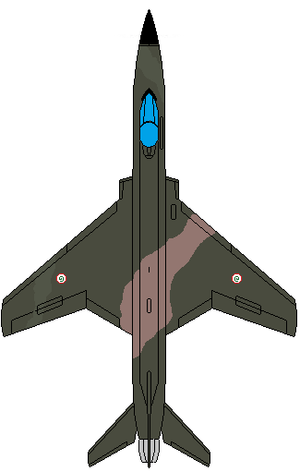Ahuriri Aerospace Kērangi: Difference between revisions
No edit summary |
No edit summary |
||
| Line 22: | Line 22: | ||
|} | |} | ||
The '''Ahuriri Aerospace Kērangi''' is an Onekawan supersonic fighter-bomber that saw service with the [[Royal Onekawa-Nukanoa Air Force]] and [[Royal Onekawa-Nukanoa Navy]]. Originally a large, twin-engined single-seat carrier-capable interceptor with secondary ground-attack capability the design proved capable of support significant modification and modernization efforts. Developed into a multirole air superiority and strike platform as | The '''Ahuriri Aerospace Kērangi''' is an Onekawan supersonic fighter-bomber that saw service with the [[Royal Onekawa-Nukanoa Air Force]] and [[Royal Onekawa-Nukanoa Navy]]. Originally a large, twin-engined single-seat carrier-capable interceptor with secondary ground-attack capability the design proved capable of support significant modification and modernization efforts. Developed into a multirole air superiority and strike platform as the FG.5, it would also see a variety of specialized variants for specific roles that saw servive into the mid-90s after its replacement by the [[Arthuristan Dynamics Cyclone]] in air superiority and ground-attack missions in 1989. | ||
==Specifications (Kērangi F.3)== | ==Specifications (Kērangi F.3)== | ||
Revision as of 21:45, 3 October 2020
This article is incomplete because it is pending further input from participants, or it is a work-in-progress by one author. Please comment on this article's talk page to share your input, comments and questions. Note: To contribute to this article, you may need to seek help from the author(s) of this page. |
| Ahuriri Aerospace Kērangi | |
|---|---|
| Role | Fighter-bomber |
| Manufacturer | Ahuriri Aerospace |
| First flight | 1957 |
| Introduction | 1960 |
| Retired | 1989 |
| Status | Retired |
| Primary user | Royal Onekawa-Nukanoa Air Force, Royal Onekawa-Nukanoa Navy |
The Ahuriri Aerospace Kērangi is an Onekawan supersonic fighter-bomber that saw service with the Royal Onekawa-Nukanoa Air Force and Royal Onekawa-Nukanoa Navy. Originally a large, twin-engined single-seat carrier-capable interceptor with secondary ground-attack capability the design proved capable of support significant modification and modernization efforts. Developed into a multirole air superiority and strike platform as the FG.5, it would also see a variety of specialized variants for specific roles that saw servive into the mid-90s after its replacement by the Arthuristan Dynamics Cyclone in air superiority and ground-attack missions in 1989.
Specifications (Kērangi F.3)
- Crew: 1/2
- Engines: 2 x AA Henaki 230 Turbojets, each producing 12,000lbf (53.37 kN) and 18,200 lbf (80.95 kN) with afterburner
- Wingspan: 12.68m
- Length: 19.88m
- Height: 6.09m
- Empty Weight: 12,181kgs
- Top Speed: Mach 2.1
- Ceiling: 48,500 ft
- Combat Radius: 1,250km
- Sensors: OSVA RR.110 Radar
- Armaments: 1 x 20mm gatling cannon, 9 total hardpoints: 6 x under-wing, 3 x centreline pylons with total capacity for 8,500kgs of munitions
